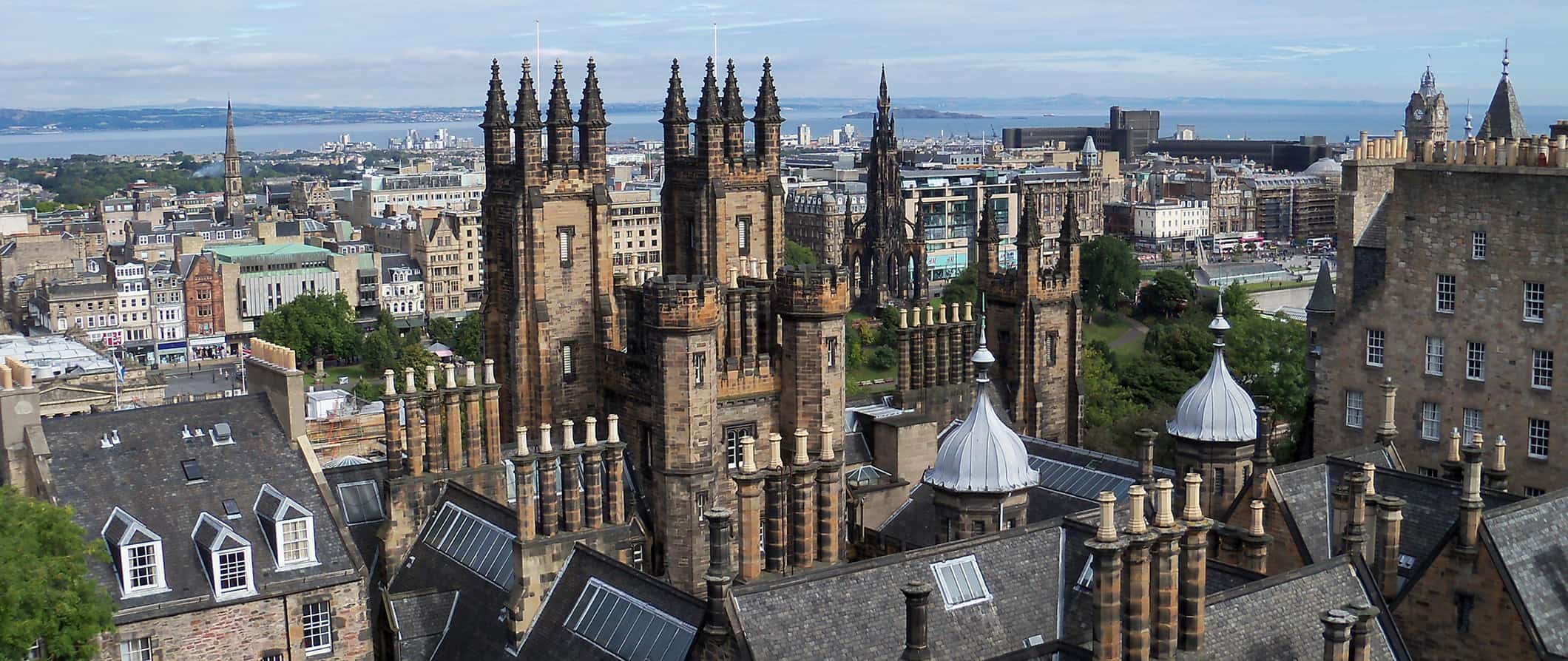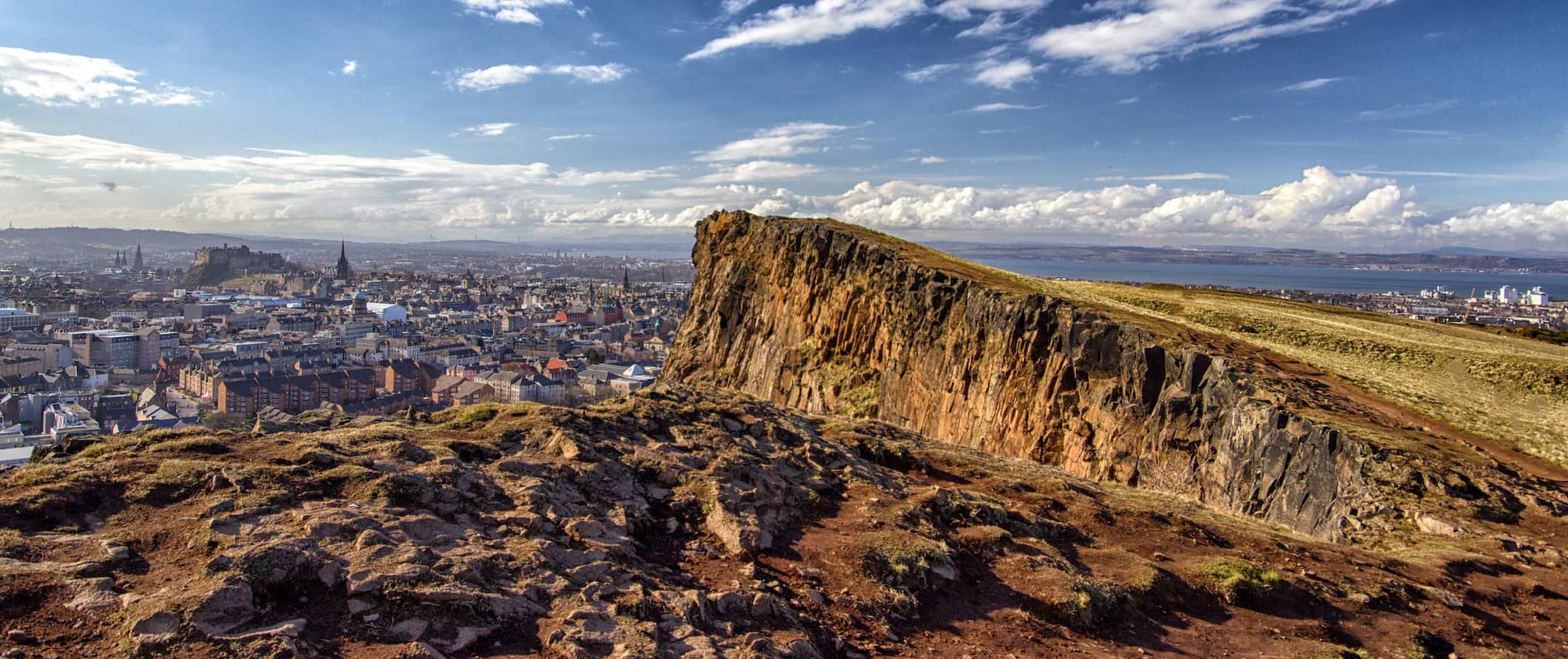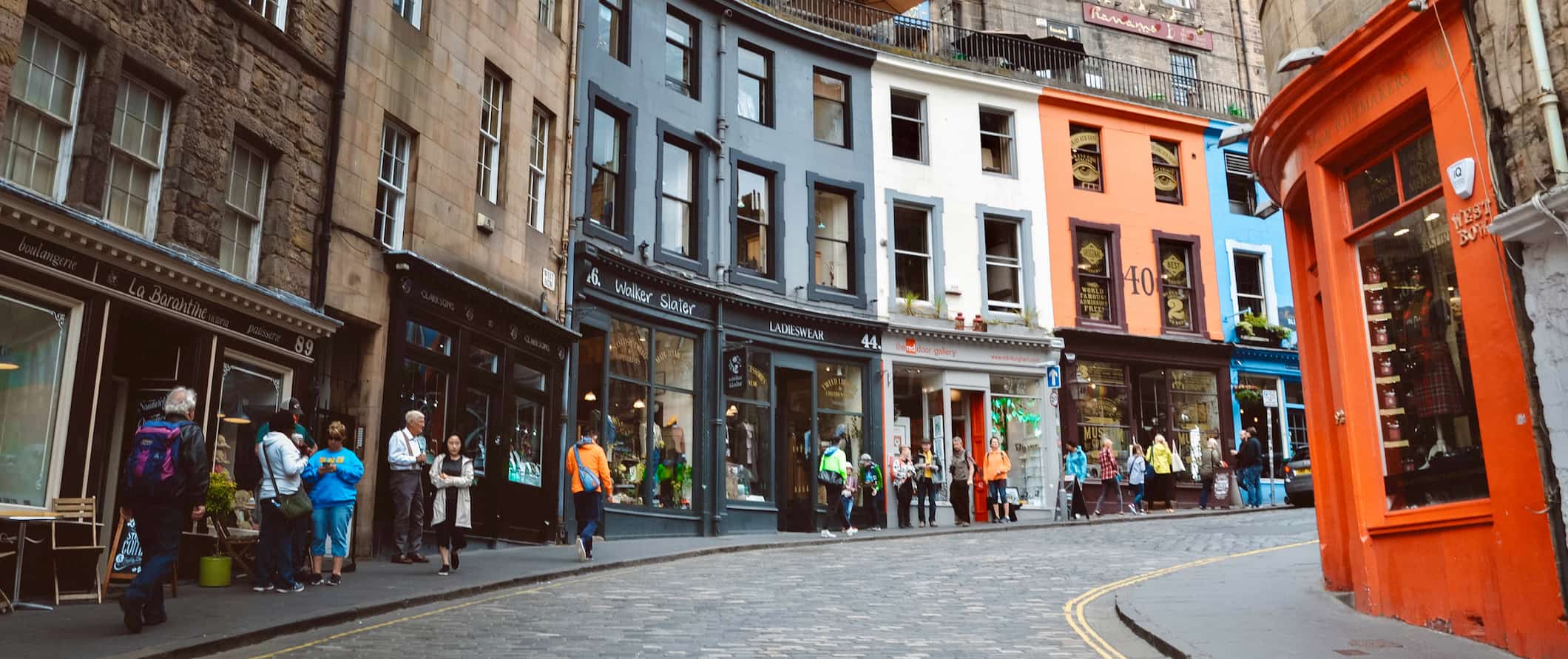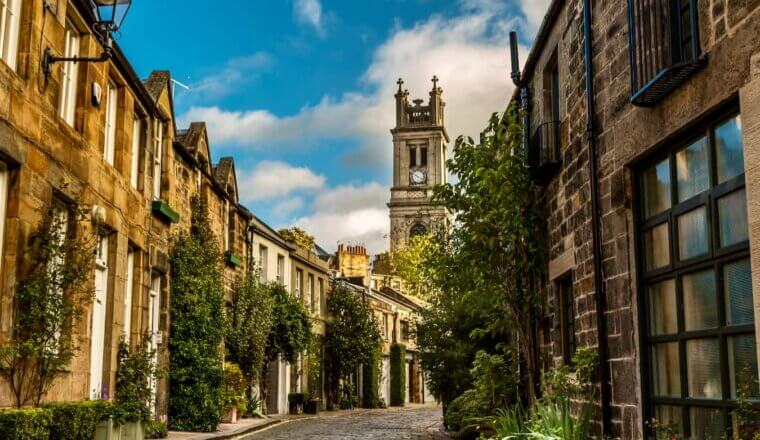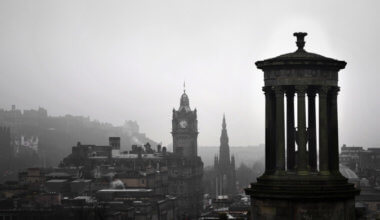Edinburgh is one of my favorite cities in the world. I love the cobblestone streets of the historic Royal Mile, the free museums, the lively locals always ready to share a beer, and the insane amount of world-class whisky to be found (and tasted). I’ve been here a bunch of times and it’s always a blast.
As the capital of Scotland since the 15th century, Edinburgh has a rich history (especially literary history; the city was designated a UNESCO City of Literature in 2004). Both the Old Town and New Town are also UNESCO World Heritage sites and there are centuries of myths and legends about the spooky underbelly of the city (which you can learn about on a haunted ghost tour.
As the second-most visited city in the UK, there are tons of things to see and do here no matter what your interests are. There are beautiful walks, historic buildings, lively pubs, huge festivals (such as the Edinburgh Fringe Festival and Hogmanay), a castle, Harry Potter tours, and much, much more.
This travel guide to Edinburgh can help you plan your trip, save money, and make the most of your visit to this historic and picturesque city!
Table of Contents
Top 5 Things to See and Do in Edinburgh
1. Visit Edinburgh Castle
Built in the 12th century, Edinburgh Castle sits on a hill overlooking the city’s Old Town. It’s the most besieged place in Great Britain and you can easily spend hours here exploring and learning the castle’s history (the Crown Jewel exhibit is worth the price alone). Admission is 15.50 GBP.
2. Hike to Arthur’s Seat
Arthur’s Seat is an extinct volcano on the outskirts of Edinburgh. With a height of 251 meters (823 feet), it provides hikers with a picturesque panorama of the city. The hike takes an hour each way. If the weather is nice, bring a picnic and spend an afternoon looking out over the city.
3. Walk the Royal Mile
This pedestrian road is lined with pubs, restaurants, and shops. While touristy (it can get crowded in the summer), it’s also incredibly beautiful and historic. There are many historical monuments and buildings to check out nearby, such as the medieval St. Giles’ Cathedral.
4. Tour Rosslyn Chapel
Founded in 1446, this historic chapel near Edinburgh was made famous in The Da Vinci Code. The chapel is ripe with intricate artwork and symbolism that has spawned many conspiracy theories. Located just an hour from Edinburgh, admission is 9.50 GBP.
5. See the Scott Monument
Built in 1846, the Scott Monument commemorates the life of Sir Walter Scott, the author of such famous novels as Ivanhoe and Rob Roy. The Gothic spire monument was created to honor his works and contributions to Scottish culture as well as to the city of Edinburgh itself. Admission is 8 GBP.
Other Things to See and Do in Edinburgh
1. Take a free walking tour
The best way to get the lay of the land is to take a walking tour. You get a feel for the city and get to see the main sights while also having a local expert on hand to answer your questions. I always take a free walking tour when I arrive at a new destination. It’s the best way to get situated. New Europe has a great free tour that lasts a couple of hours — just be sure to tip your guide at the end!
2. Hang out in Calton Hill
Calton Hill is a quiet place to escape the noise of the city and admire the view. Take a hike to the top of the hill where you can sit and relax in a peaceful park-like setting. The National Monument of Scotland (a memorial to the soldiers who fought in the Napoleonic Wars between 1803-1815) and the Nelson Monument, dedicated to Horatio Nelson (a famous 18th-century British Admiral) are located here.
3. Explore Princes Street Gardens
For another free outing, spend an afternoon at Princes Street Gardens, which boasts a beautiful view of Edinburgh Castle. The garden is composed of two main parks and dates to the 1770s, when Edinburgh’s largest lake, Nor Loch, was drained to create the park. Today, the park is beloved by tourists and visitors alike, with vendors selling food and souvenirs here. At Christmas, the Garden turns into a German-style winter fair, full of stalls selling food, mulled wine, toys, and rides (the Christmas markets usually open mid-November).
4. Tour the Museum of Edinburgh
This museum is in the 16th-century Huntly House (one of the historic buildings on the Royal Mile) and offers insight into the city and its past. The museum is home to the National Covenant (an important Scottish Presbyterian document from 1638) as well as some original city plans and a miniature of the Old Town. There are also works of art, silverware, weapons, and more. The museum is free.
5. Visit the National Gallery of Scotland
This impressive gallery is home to works by Monet, Rembrandt, Degas, Vermeer, and Van Gogh, as well as works by famous Scottish painters like Allan Ramsay, David Wilkie, and William McTaggart. Opened in 1859, the gallery was designed in the Neoclassical style to look like an ancient Greek temple. Works span the centuries from the Renaissance to the 20th century and the gallery is free to enter (some temporary exhibits have a fee).
6. Attend a summer festival
During the summer, Edinburgh is home to several huge festivals. The most popular is the Edinburgh Fringe Festival. Held in August, this festival brings in performers and entertainers of all kinds — actors, musicians, buskers, and more. The festival lasts three weeks and is the biggest festival of its kind in the world. Keep in mind that during this time, accommodation prices skyrocket and the city floods with people. If you plan to attend, make sure you book your accommodation in advance. The Edinburgh International Film Festival in June and the Edinburgh Jazz Festival in July are two other big festivals worth attending in the summer.
7. Take a ghost tour
Edinburgh has a spooky history and there are many tours that illuminate the city’s eerie past by taking you around to graveyards and through underground tunnels. Even if you don’t believe in ghosts, the tours take you to some old and interesting parts of Edinburgh. Don’t miss the Ghost Bus tour as well as a tour of the Vaults (the underground tunnels below the city) — both of which you do at night!
8. Drink some scotch
Learn how scotch is made by touring the Scotch Whisky Experience. It’s part museum, part interactive attraction (there’s even a barrel ride where you sit in a fake barrel and learn about the whisky-making process). There are also exhibits to show you the history of Scotland’s famous drink and how it came to hold such a revered place in the culture. Prices vary depending on what type of tour you want but begin at 17 GBP.
9. Celebrate Hogmanay
Hogmanay is one of the world’s biggest and most famous New Year’s Eve celebrations. Tens of thousands of people gather in the city streets to celebrate with torchlight processions, concerts, and fireworks. Prepare yourself for lots of drinking, holiday festivities, live music, and huge crowds. Book your accommodation far in advance as tens of thousands of people attend the festival.
10. Have fun at Camera Obscura
Founded in 1835, Camera Obscura is a fun and educational interactive museum. It’s home to over 100 exhibits that use light, mirrors, and technology to create stunning optical illusions. It’s located right in the heart of the Old Town making it easily accessible for anyone traveling with kids (or anyone who wants to indulge their inner child). It’s part science, part illusion, and all fun. Admission is 18 GBP.
11. Take a Harry Potter tour
If you’re a fan of J.K. Rowling’s epic fantasy series, be sure to book a spot on The Potter Trail, Edinburgh’s original Harry Potter tour. Tours are held daily and cover all the main sites in the city that relate to the books. The tour lasts 90 minutes and is accessible for both casual enthusiasts as well as die-hard fans. The tour is free, though make sure to tip your guides as well.
12. Visit St. Giles’ Cathedral
Also known as the High Kirk of Edinburgh, St. Giles’ Cathedral is located on the Royal Mile and was originally built in the 12th century. The current building dates to the 14th century and was formerly a Roman Catholic Cathedral (St. Giles is now part of the Church of Scotland). In addition to the beautiful and austere interior, the cathedral is home to some noteworthy monuments, including one to famed Scottish author Robert Louis Stevenson, who wrote Treasure Island and The Strange Case of Dr. Jekyll and Mr. Hyde. Admission is free. Remember that this is a place of worship, so dress respectfully.
For more information on other cities in Scotland, check out these guides:
Edinburgh Travel Costs
Hostel prices – Most 4-8-bed dorms cost 16-22 GBP, while a bed in a dorm with 10 or more beds costs 12-14 GBP per night. Prices tend to rise a few pounds in the summer and drop a few in the winter. Private double rooms cost 50-75 GBP per night.
Free Wi-Fi and lockers are standard and most hostels also have self-catering facilities. Free breakfast is rare, but a few hostels in the city do offer it. Be sure to book those hostels in advance if it’s a priority.
Budget hotel prices – Budget hotels cost around 50-65 GBP per night. These usually include free Wi-Fi and some offer free breakfast.
A private Airbnb room costs 30 GBP per night while entire homes/apartments start at 55 GBP per night (though most cost 70 GBP per night or more).
For those traveling with a tent, camping is another option here — especially if you head out to the nearby Loch Lomond National Park. Expect to pay around 17 GBP per night for a basic plot (which is just a flat space for a tent; electricity is generally not included). Most parks close for the winter, so availability is limited come late October/early November. If you’re in a car or campervan, you can use the app ‘park4night’ to find paid overnight parking, free overnight parking, and campgrounds.
Food – Scottish food is hearty, heavy, and filling. Seafood is abundant, and popular traditional dishes include blood pudding, minced beef, fish and chips, smoked herring, neeps and tatties (turnips and potatoes), and of course haggis (a dish composed of minced sheep’s organs and spices inside a sheep’s stomach casing). Porridge is a common breakfast choice, though a larger breakfast of sausage, eggs, beans, and bread is not uncommon either. Sticky toffee pudding is a favorite dessert, and of course, you can’t visit Scotland without sampling some scotch.
Expect to pay around 10-12 GBP for a basic meal like a Scottish breakfast or haggis. For pub food like fish and chips or a burger, prices are usually between 15-25 GBP. For a full three-course meal at a mid-range restaurant, prices begin around 30 GBP.
A pint of beer is 4 GBP while a glass of wine is around 5.50 GBP. A latte or cappuccino is around 2.70 GBP.
A classic fish and chips from a no-frills takeaway spot is around 6 GBP. Chinese takeout is around 8-10 GBP, while a basic fast food combo meal (think McDonald’s) costs around 6 GBP. Street food (like from a food truck) costs around 6-8 GBP.
The Mosque Kitchen is one of the cheapest restaurants in the entire city. You can get an excellent meal there for 6-8 GBP.
For a week’s worth of groceries, expect to pay 40-60 GBP. This covers basic staples like pasta, rice, seasonal produce, and some meat. The cheapest supermarkets to look out for are Aldi, Lidl, Asda, and Tesco.
Backpacking Edinburgh Suggested Budgets
On a backpacker budget, you can visit Edinburgh for about 55 GBP per day. This means staying in a dorm room or camping, cooking all of your meals, limiting your drinking, sticking to mostly free activities like hiking and free walking tours, and using public transportation to get around.
On a mid-range budget of about 100 GBP per day, you can stay in a private Airbnb room, eat out for most of your meals (sticking to a lot of pub foods), do more paid activities like visiting museums or galleries, enjoying a couple of drinks at the bar, and taking the occasional taxi to get around. You’re not going to live large, but you can get by without worrying too much about your spending.
On a “luxury” budget of 200 GBP or more per day, you can stay in a hotel, eat out for every meal, drink what you want, and visit as many museums and attractions as you’d like, take taxis, and do whatever else you want. This is just the ground floor for luxury though — you can easily spend more if you really want to splash out!
Edinburgh Travel Guide: Money-Saving Tips
Like the rest of the UK, Edinburgh can be expensive. Fortunately, there are lots of ways to lower your costs and save money here. Here are some quick tips to help you save money in Edinburgh:
- Get the Edinburgh City Pass – If you’re planning to explore Edinburgh, get the City Pass. For 45 GBP, you’ll get access to 22 attractions as well as free transportation to and from the airport. There is also a two-day pass for 55 GBP and a three-day pass for 65 GBP. It’s a good choice for anyone planning to see a lot.
- Eat in a pub – The best food is often in the pubs and at a fraction of the price when compared to a sit-down restaurant. If you’re going to eat out, eat here.
- Eat during lunch – Many cafes, bakeries, nd chains offer lunch deals for as little as 3-5 GBP.
- Use apps to get discounted food – The app Too Good to Go, (on which participating eateries sell severely discounted meals/groceries/baked goods at the end of the day) has good coverage all across Scotland, particularly in Edinburgh. For discounts on takeout try the app Secret Takeaways which supports local restaurants by cutting out the delivery app middlemen (and their high fees).
- Visit the free museums – The public museums in Scotland are free — so take advantage! Free attractions include The National Museum of Scotland, Scottish National Gallery, St. Giles Cathedral, the Royal Botanic Garden, and the Scottish National Gallery of Modern Art.
- Avoid eating and shopping in the city centers – Edinburgh is significantly more expensive the closer you get to the city center/Old Town. There are plenty of good restaurants and quirky shops outside of the center, so go for those. Trust me, you won’t be disappointed.
- Stay with a local – Couchsurfing is the best way to save on accommodation as it’s free! You’ll not only save money but have access to a knowledgeable local who can help point you to some of the city’s hidden gems.
- Take a free walking tour – If you want to learn more about the history, architecture, and people of Scotland then be sure to take a free walking tour. They usually last a couple of hours and are a great introduction to the city.
- Cook your own meals – Food in the UK isn’t cheap. Save yourself some money and cook a few meals for yourself. It may not be as fancy as eating out, but your wallet will thank you!
- Use discount websites – Groupon, Wowcher and Living Social have good deals on accommodation, attractions, and dining out.
- Bring a water bottle – The tap water here is safe to drink so bring a reusable water bottle to save money and reduce your plastic use. LifeStraw is my go-to brand as their bottles have built-in filters to ensure your water is always clean and safe.
Where to Stay in Edinburgh
Edinburgh has plenty of hostels and they’re all pretty comfortable and sociable. These are my favorite places to stay in Edinburgh:
How to Get Around Edinburgh
Public transportation – Buses and trams are the most common forms of public transportation in the city. A single ticket costs 1.80 GBP and goes up from there depending on how far you go. Buses take only exact change so you may want to download the “Transport for Edinburgh” app to pay for tickets on your phone instead. You can even use it to buy tram tickets to/from the airport.
Day passes can be purchased for 4.40 GBP and a one-week ticket costs 20 GBP (does include the airport).
The Airlink bus to the airport costs 4.50 GBP for the 30-minute journey, while the tram costs 6 GBP.
Taxi – Taxis aren’t cheap here so I would avoid them as much as possible. Rates start at 3 GBP and go up by 1.40 GBP per kilometer. Stick to public transportation if you’re on a budget unless you are splitting the ride with someone.
Gett and Free Now are the two most common platforms used for taxis (they are linked to the Google Maps app so you can use that to get price estimates if you’re comparing modes of transportation). That being said, Edinburgh has safe and reliable public transportation, so I’d avoid taxis and ridesharing unless you have no other options.
Ridesharing – Uber is available in Edinburgh, but it’s not always cheaper than taxis.
Car rental – Scotland is a great road trip destination, though I would only rent a car if you’re leaving the city (or if you need it for a specific reason in the city). Getting around the city is easier without a vehicle as public transportation is reliable. I would avoid renting a car unless you’re leaving the city.
You can find rentals for 25 GBP per day and campers for as little as 30 GBP per day. Just remember that traffic flows on the left. Most vehicles are manual transmissions as well.
Bicycle – Edinburgh currently has no city-wide bike share system. If you want to rent a bike, hire one from bike rental shops Cycle Scotland or The Tartan Bicycle Company. Bikes are 25-30 GBP per day, while e-bikes run 45 GBP per day. You can also take a bike tour with Edinburgh Bike Tours (starting at 39 GBP, including bike rental).
When to Go to Edinburgh
Summer is the most popular time to visit Edinburgh. In July and August, there’s warm weather and minimal rain, with temperatures reaching highs of around 20°C (68°F). This is also the busiest time of the year, so expect crowds in the cities and lots of people out enjoying the nearby national parks. The Edinburgh Fringe Festival takes place in August, which is a huge multi-week festival. Be sure to book your accommodation in advance if you’re visiting during this time.
September is a rather wet month, though October offers incredible fall foliage. It’s a good month for road trips — especially if you plan on renting a car or camper and heading into the Cairngorms (Scotland’s biggest national park, which is only a couple of hours from the city). Seasonal businesses and accommodations start to close in mid-October so be sure to keep that in mind when planning. Expect October temperatures to hover around 12°C (55°F) during the day.
The spring is a great time to visit, with April and May offering minimal rain and no crowds. There’s snow and cool temperatures in the highlands, but the city is lively without being crowded.
Winters in Scotland are cold and dark. December is relatively dry but the temperatures dip close to 0°C (32°F). It’s nevertheless a popular time to visit, with many tourists coming to Edinburgh for the huge Hogmanay New Year’s Eve celebration (one of the biggest New Year’s festivals in the world).
By February, snow is common so keep that in mind if you plan on renting a vehicle. Unless you’re coming to engage in winter sports, I’d avoid a winter visit unless you don’t mind the grim and grey atmosphere of the country.
How to Stay Safe in Edinburgh
Scotland is a safe country, and you won’t need to worry about crime while you’re here. Edinburgh is safe for solo travelers — including female travelers — though women should take the standard precautions when traveling alone at night (don’t travel alone intoxicated, keep an eye on your drink, etc.).
As in all cities, stay vigilant when you’re in crowded tourist areas and on public transportation as that is when pickpockets usually strike. Always keep your valuables secure and out of reach just to be safe.
If you are hiking nearby (for example, in the Cairngorms a few hours north) make sure you have the appropriate equipment and that you notify your accommodation of your plans just in case. And if you’re hiking Arthur’s Seat, expect windy conditions at the summit.
While scams here are rare, you can read about common travel scams to avoid here if you’re concerned.
If you experience an emergency, dial 999 for assistance.
The most important piece of advice I can offer is to purchase good travel insurance. Travel insurance protects you against illness, injury, theft, and cancellations. It’s comprehensive protection in case anything goes wrong. I never go on a trip without it as I’ve had to use it many times in the past. You can use the widget below to find the policy right for you:
Edinburgh Travel Guide: The Best Booking Resources
These are my favorite companies to use when I travel. They consistently have the best deals, offer world-class customer service and great value, and overall, are better than their competitors. They are the companies I use the most and are always the starting point in my search for travel deals.
- Skyscanner – Skyscanner is my favorite flight search engine. They search small websites and budget airlines that larger search sites tend to miss. They are hands down the number one place to start.
- Hostelworld – This is the best hostel accommodation site out there with the largest inventory, best search interface, and widest availability.
- Booking.com – The best all around booking site that constantly provides the cheapest and lowest rates. They have the widest selection of budget accommodation. In all my tests, they’ve always had the cheapest rates out of all the booking websites.
- Get Your Guide – Get Your Guide is a huge online marketplace for tours and excursions. They have tons of tour options available in cities all around the world, including everything from cooking classes, walking tours, street art lessons, and more!
- SafetyWing – Safety Wing offers convenient and affordable plans tailored to digital nomads and long-term travelers. They have cheap monthly plans, great customer service, and an easy-to-use claims process that makes it perfect for those on the road.
- LifeStraw – My go-to company for reusable water bottles with built-in filters so you can ensure your drinking water is always clean and safe.
- Unbound Merino – They make lightweight, durable, easy-to-clean travel clothing.
- Top Travel Credit Cards – Points are the best way to cut down travel expenses. Here’s my favorite point earning credit cards so you can get free travel!
- BlaBlaCar – BlaBlaCar is a ridesharing website that lets you share rides with vetted local drivers by pitching in for gas. You simply request a seat, they approve, and off you go! It’s a cheaper and more interesting way to travel than by bus or train!
Edinburgh Travel Guide: Related Articles
Want more info? Check out all the articles I’ve written on backpacking/traveling Scotland and continue planning your trip:
